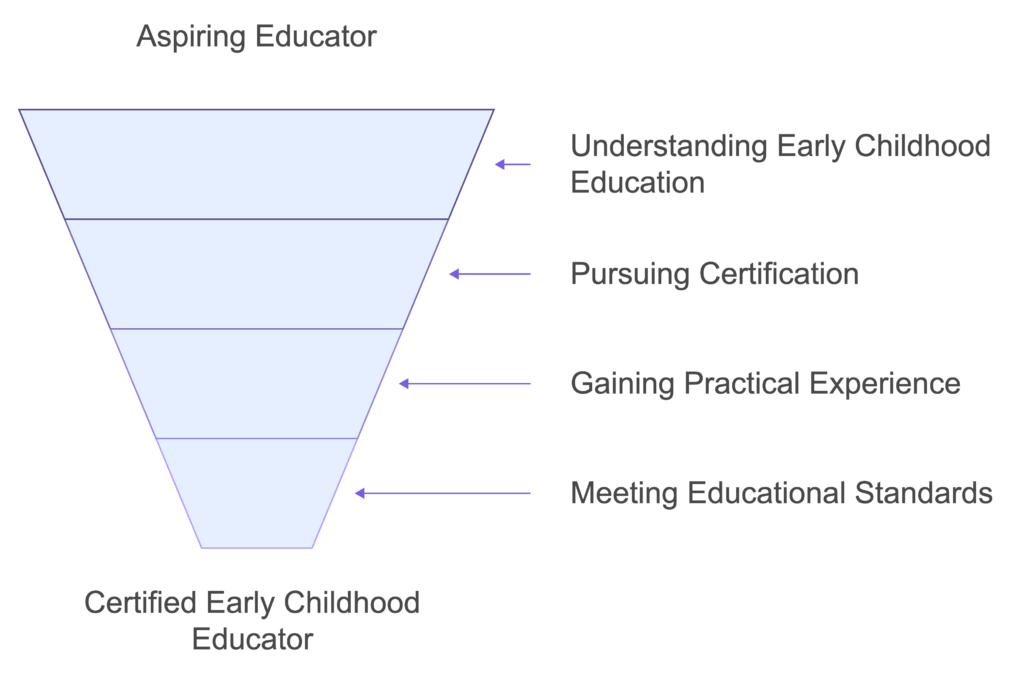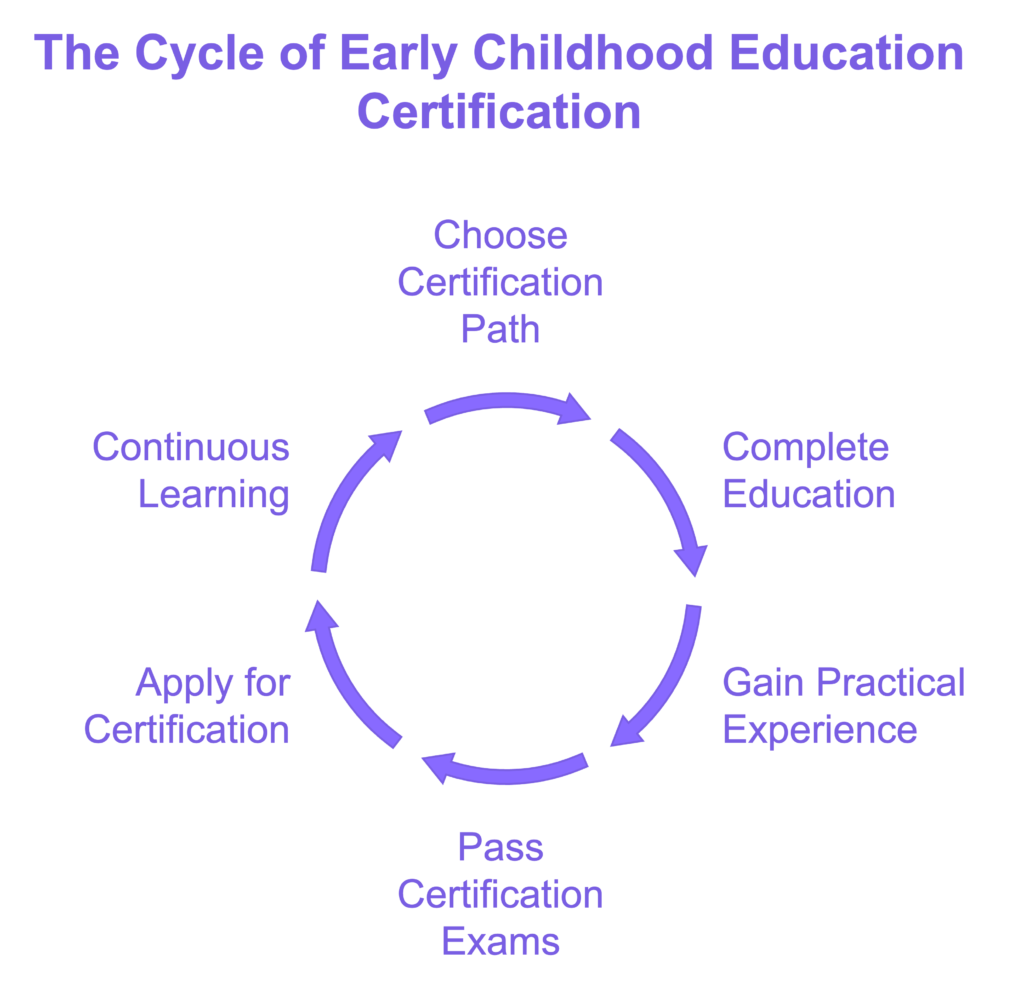
The journey to becoming an early childhood educator is more than just the pursuit of a career. It is the beginning of a lifelong mission to guide the delicate minds of young children, respecting their individuality while helping them to explore the world at their own pace.
For those passionate about nurturing young learners, getting certified in early childhood education is a natural step toward fulfilling this calling.
In this guide, we will explore the pathways to certification in early childhood education, discuss the skills required, and reflect on the true value of becoming a certified professional in this field.
What Is Early Childhood Education?
Early childhood education focuses on the critical period of development from birth to around eight years of age. During these years, children’s minds are like fertile soil, ready to absorb and grow from every new experience.
A well-prepared educator plants the seeds of curiosity, creativity, and love for learning, creating a lasting foundation for the child.
Certification in early childhood education is a recognition that you possess the knowledge, skills, and philosophy needed to support young children during these formative years.
It is about understanding their needs, creating safe and stimulating environments, and guiding them to grow into well-rounded individuals.
But beyond the theoretical knowledge, it is also about the imperfections, the challenges, and the deeply human experiences that come with teaching young children.
Why Certification Matters
The early years are crucial, as they shape a child’s learning, social behavior, and emotional well-being. A certified early childhood educator has the training to understand not only what children need to learn, but also how they learn best. Certification ensures that educators are prepared to provide nurturing guidance, respect each child’s unique journey, and create spaces that honor the child’s natural curiosity.
But it is important to remember that education is not a perfect science. There will be days when plans fall apart, when a child is upset and you can’t seem to find the right words, or when you question whether you’re doing enough. Certification doesn’t make you immune to these moments, but it gives you the tools and resilience to navigate them.
Being certified also ensures that you meet the standards of education quality, allowing parents to trust in your abilities and institutions to rely on your expertise. This formal recognition of your skills also opens doors to opportunities in various educational settings, including preschools, childcare centers, and specialized programs.
Steps to Getting Certified in Early Childhood Education

To become certified, you need to take several steps that are designed to prepare you both practically and philosophically. Let’s take a look at each one.
Step 1: Choose the Right Certification Path
The certification process begins with selecting a path that aligns with your career goals. Some common options include:
- Child Development Associate (CDA): The CDA is one of the most popular early childhood education credentials in the United States. It requires specific coursework, hands-on experience, and a final assessment.
- Early Childhood Education Associate Degree: Many educators start with an associate degree, which provides foundational knowledge and meets certification requirements for many positions.
- Bachelor’s Degree in Early Childhood Education: A bachelor’s degree is often required for teaching positions in public schools and for leadership roles.
Your choice will depend on your aspirations—whether you wish to work in a preschool, childcare center, or a school district. No matter which path you choose, know that there will be times of doubt, struggle, and even failure. But these moments are also where the growth happens—for you as much as for the children you teach.
Step 2: Complete the Required Education
Once you have chosen the path, you will need to complete the necessary coursework. Educational programs for early childhood education generally cover topics such as:
- Child Development: Understanding the physical, emotional, cognitive, and social development of children.
- Learning Theories: A study of how children learn and how to support individual learning styles.
- Curriculum Planning: Methods for designing a curriculum that encourages exploration, play, and learning in developmentally appropriate ways.
- Family and Community Engagement: Learning how to foster relationships with families and the community to support a child’s growth.
This coursework not only provides a theoretical understanding of the child’s development but also gives practical approaches to supporting each child’s journey. And let’s not forget that, in practice, there will be times when the theories don’t seem to apply, when a child needs something that can’t be found in any textbook. That is where your creativity, your empathy, and your willingness to try—and sometimes fail—come into play.
Step 3: Gain Practical Experience
In addition to coursework, practical experience is essential. Most certification programs require a certain number of supervised hours in a classroom or childcare setting. This is the time where the theories learned in class come alive. You will observe how children interact, explore, and grow, while learning how to respond thoughtfully to their needs.
During these practical experiences, you will make mistakes. You might find yourself struggling to keep a group of children focused, or unsure of how to comfort a child who is crying for reasons you cannot understand. These moments can feel overwhelming, but they are also the moments that teach you the most. It is in these imperfections that you truly learn how to be an educator.
Step 4: Pass Certification Exams
Depending on your chosen path, you will be required to pass an examination or assessment that tests your knowledge and skills in early childhood education. For instance, if you are pursuing a CDA, you will need to compile a professional portfolio and pass a verification visit.
The pressure of exams and assessments can be intense. You may find yourself second-guessing your knowledge or feeling anxious about being evaluated. Remember, this too is part of the process. It is a test not just of your knowledge, but of your perseverance.
Step 5: Apply for Your Certification
Once you have met the educational and practical requirements and passed any exams, the next step is to apply for certification. This process typically includes submitting proof of your education, practical experience, and exam results to a certifying organization, such as the Council for Professional Recognition (for CDA certification).
The process of applying might feel like a culmination, but it is really just the beginning. It marks the start of a journey where learning never ends, and where each day brings new challenges and opportunities to grow.
Important Qualities of a Certified Early Childhood Educator
Certification is not simply about meeting requirements and passing exams; it is also about nurturing qualities that are essential for early childhood educators. These qualities allow you to engage effectively with children, support their natural growth, and create learning environments that honor the child’s curiosity.
Patience
Children learn at different paces, and an effective educator respects and accommodates these differences. Patience is crucial when working with young learners, as they explore the world and make mistakes. The certified educator approaches every child’s journey with a calm and positive attitude. But patience is not always easy. There will be times when you feel frustrated, when you feel like you’ve explained something countless times without progress. It is in these moments that patience becomes a choice—a commitment to seeing the child through.
Creativity
A certified educator uses creativity to craft meaningful learning experiences. This might mean turning a simple walk outdoors into a lesson on nature or using a box of colored blocks to teach problem-solving. The ability to see the learning opportunity in every moment is what helps ignite a child’s love for discovery. Creativity also means being adaptable—knowing that some days, plans will need to change, and you will have to improvise. It means embracing the unexpected, even when it feels chaotic.
Observation Skills
Observation is one of the most powerful tools in an educator’s toolkit. Watching children play and interact provides insights into their development, needs, and interests. With careful observation, the educator can adapt activities to better serve the child’s learning experience. However, observation also requires humility. You may think you understand what a child needs, only to realize you’ve missed something important. It is about being willing to learn, to see the child for who they are, rather than who you expect them to be.
Empathy
Empathy helps in understanding each child’s perspective. It’s the ability to sense when a child feels uncertain or needs reassurance. Empathetic educators build trust with their students, creating a safe space where children feel confident to explore and learn. But empathy, too, can be challenging. There will be days when you are tired, when your own frustrations make it hard to connect. It is in these moments that empathy becomes an act of will—a reminder of why you chose this path.
Choosing a Program That Aligns With Your Values
Not all certification programs are created equal, and it is important to choose one that aligns with your values and educational philosophy. Look for programs that emphasize:
- Respect for the Child: The best programs recognize that children are unique individuals with their own ways of learning. They do not enforce a one-size-fits-all approach.
- Hands-On Learning: Programs that focus on experiential learning prepare educators to interact effectively with children. Learning by doing is essential to grasping how to support young children in real-world settings.
- Community Engagement: Programs that prioritize partnerships with families and communities create a more holistic approach to education, preparing educators to involve parents and create strong support networks for children.
Career Opportunities After Certification
After receiving certification, a range of career opportunities opens up. Some options include:
Preschool Teacher
As a preschool teacher, you will guide children through their first experiences of structured education, nurturing their cognitive and social skills in a play-based environment.
Childcare Center Director
With additional education and experience, certified educators can move into leadership positions as directors of childcare centers, overseeing program development, staff training, and center operations. The role of a director is demanding, often involving long hours and complex challenges, but it also offers the opportunity to shape an entire educational environment.
Special Education Assistant
Some children have special needs that require additional support. Certified educators may work in specialized settings to support these children, ensuring they receive the attention and guidance they need to thrive. This role requires a deep well of patience and compassion, as progress can be slow, and setbacks are common. But it is also one of the most rewarding paths, offering the chance to make a profound difference in the life of a child who needs extra care.
Family Support Specialist
Certified professionals can also work closely with families to ensure the home environment complements the child’s educational experience, guiding parents on how best to support their child’s development. This role involves listening without judgment, offering advice while respecting each family’s unique dynamics, and recognizing that there is no single “right” way to raise a child.
Continuing Education and Professional Development
The learning does not stop with certification. As educators, our understanding of children and the ways they learn continues to evolve. Continuing education allows certified educators to stay updated on the latest research, learn new teaching techniques, and keep their approaches fresh and responsive.
Many institutions provide workshops, courses, and conferences that offer further insight into areas such as child psychology, early intervention strategies, and advanced curriculum planning. Embracing these opportunities means embracing the reality that you, too, are a lifelong learner. There will be times when you feel overwhelmed by how much there is still to learn, but this humility is part of what makes you a better educator.
The Gift of Certification
Becoming certified in early childhood education is not simply a means to obtain a job—it is a commitment to nurturing the human spirit during its most vulnerable and formative years. It is about recognizing that each child is on their own journey and that, as educators, our role is to provide them with the tools, encouragement, and environment they need to flourish.
Certification is a recognition of your readiness to take on this role. It reflects your dedication, your skills, and your unwavering respect for the individuality of every child. It is also a reminder that, as an educator, you will make mistakes. There will be days when you feel you have failed a child, when the lesson you planned falls flat, or when your patience runs thin. These moments do not define your worth as an educator—what matters is how you respond, how you learn, and how you keep striving to do better.
As you embark on this journey, remember that the most important part of early childhood education is not just the lessons you teach but the love for learning you inspire. The imperfections, the struggles, and the human emotions you bring to your role are not flaws—they are the very things that make you capable of truly touching a child’s life.
Taking the Next Step
If you feel the call to nurture and educate young children, take the next step toward becoming certified. Reflect on your values, choose a path that aligns with your goals, and seek out the education and experience that will equip you for this deeply rewarding role. There will be challenges, there will be doubts, and there will be times when you feel lost—but there will also be moments of pure joy, when a child’s eyes light up with understanding or when a simple word of encouragement makes all the difference.
These moments are the reason we teach. They are the reason we strive, the reason we keep learning, and the reason we continue, day after day, to nurture the young minds that will shape our future. Certification is just the beginning—a foundation upon which you will build a career, a passion, and a lifelong dedication to helping children grow.
As you move forward, take heart in knowing that every step you take toward certification is a step toward making a meaningful impact on the lives of children. It is a path filled with challenges, but also with incredible rewards. Embrace the journey, embrace the imperfections, and most importantly, embrace the opportunity to be a guiding light in a child’s life.
